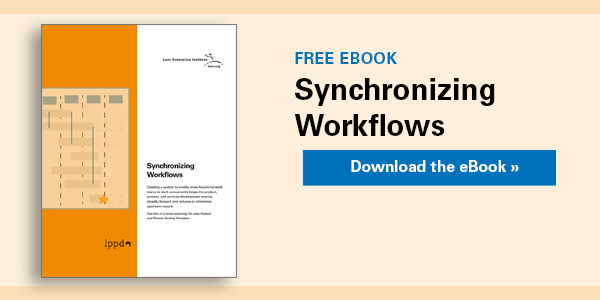Be among the first to get the latest insights from LEI’s Lean Product and Process Development (LPPD) thought leaders and practitioners. Subscribers to The Design Brief, LEI’s newsletter devoted to improving organizations’ innovation capability, received this video and article. Subscribe now.
Question: I feel like we do a lot of planning at our company, yet we still struggle to get good flow on our projects. We have been experimenting with Obeya, and that has helped a bit, but we still frequently slide our scheduled dates or push work before it’s complete, leading to the inevitable rework later in the project. What are we missing?
Response: Thank you for your question. I wish I had a simple solution to give you, but, unfortunately, I don’t! Your problem is one that many organizations grapple with every day and has several facets to it. However, the core of the issue lies with the topic of this month’s design brief – synchronizing workflows.
Fixing Common ‘Planning’ Problems
First, let’s start with the part of your question about planning. When working with companies, I hear some people say they do too much planning and others who say they do not do enough. I believe it is less about the time and effort expended than it is about the quality of the process.
I find many planning activities more focused on asking everyone what needs to be done and when they can have their tasks completed. Teams then go through several iterations of the plan to make it fit into a pre-defined timeline. Frequently, these planning activities become a series of negotiations on allocating time and resources rather than focusing on the flow of work that needs to be accomplished to meet the project’s goals. The root cause of the problem often is that we don’t understand how our work fits into the overall development process and how everyone else’s work affects ours. This knowledge gap leads to a lot of misunderstanding — and mistrust. Everyone thinks the other group is either sandbagging their estimates or exaggerating their capabilities to deliver.
Product Development Value Stream Mapping is a good way for teams to understand better how everyone’s work fits together and see where the interdependencies between groups occur (or should occur) to enable flow. Just like product development, understanding the value stream is a team sport and cannot just be the project manager’s responsibility. The more team members deeply understand each others’ work, the more they can work concurrently and flow smaller increments of stable yet incomplete information to truly flow. This practice of delivering the right information, at the right quality, at the right time in product development is analogous to the just-in-time principle in the factory.
Getting the Most from Obeya
I’m glad to hear obeya is providing some help. However, I find that many teams are missing an opportunity to get the most out of obeya. Having a visual schedule is helpful to keep all eyes on the work (assuming it was constructed with a good understanding of the value stream, as noted above). Still, the only sure thing in product development is that the original plan will change as unknowns become known and need to be addressed.
Many team huddles around obeya (or scrum) boards focus a lot of their energy on completing tasks and providing help when assignments fall behind. That is great, but how much are they talking about adjusting the inputs and outputs between groups to maintain or improve flow when these inevitable changes occur? Are they continually and proactively asking – what do you need from me? What do I need from you? In addition to improving workflow between groups, seeing each others’ work builds trust between them, leading them to become more effective problem-solvers when things do not go according to plan and improving overall team dynamics throughout the project.
Focusing more on synchronizing the workflows between tasks during the planning phase and then continually managing those flows during the project in obeya dramatically improve your time to market.
Designing the Future
An Introduction to Lean Product and Process Development.







